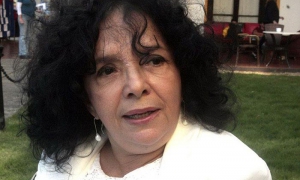The legendary Cuban musician Silvio Rodríguez began, four years ago, what he called the Gira por los barrios, (Neighborhood Tour) looking to "get music out of theaters and take it to environments closer to the people, in these difficult times." Silvio Rodríguez with pianist Frank Fernández in Mayarí. With only an enormous Cuban flag to adorn the stage, he has arrived in 56 communities, the majority outlying neighborhoods of Havana, such as Cayo Hueso, San Agustín, El Fanguito and La Hata, since the first concert in September of 2010, in La Corbata, a barrio in the Havana municipality of Playa. On several occasions, events have been held in Santa Clara, Cienfuegos and Matanzas neighborhoods, and more recently this June, in the eastern province of Holguin, in the towns of Mayarí, Nicaro and Moa. The current tour’s name, Interminable, emerged later, recalled poet Victor Casaus, speaking with Granma International, "Silvio thinks it deserves this title. It includes the exposition of Silvio’s photos taken in neighborhoods and the pastels based on these photos by Antonio Guerrero, one of the three anti-terrorist fighters who are still unjustly imprisoned in U.S. prisons. That’s what Tony called this festival of culture inaugurated in the Pablo de la Torriente Brau Center two years ago." Silvio sang several of his unforgettable pieces including " Gota de Rocío," "Reparador de Sueños," "Óleo de una mujer con sombrero" and "Ojalá." At that time, also presented was the book Enigmas y otras conversaciones, written by Tony Guerrero. In the prologue, poet Roberto Fernández Retamar writes, "Tony has created in his cell a veritable workshop which puts out poems, letters, commentaries, chronicles, a dairy and visual artwork. He stays active, lively. Just as they have not been able to extinguish his valor, they have not been able to stifle his desire to live, which shines through in his continuing creations." During that event in the Pablo Center’s Majadahonda Hall, Casaus read a message from Tony which explains the genesis of the exposition, "More than a year and a half ago, I was reading some news from Cuba, specifically about one of the concerts, and I saw some photos, which according to the caption, were taken by Silvio. They were in black and white, since the material I see is photocopied, but just that way, these images, and everything they captured, impacted me greatly. I wrote Silvio, and asked him to send me some of his photos to see if I could do some work based on them. For the first time, I took a shot at doing this kind of work. I took six of the photos and put people from different barrios in one piece. That was the beginning, with this brilliant image at the center, two young men with a very original, handmade poster saying, Viva Silvio! The population turned out for the concert in Mayarí. Silvio’s journey through the country’s barrios is a human contact tour. That is what makes it special. It is a marvel of communication. Víctor Casaus emphasized the gratitude people feel toward an artist of Silvio’s stature who brings his music to them directly, recalling a woman who saw Silvio take the stage while standing in her front door, who said at the close of the concert, "It makes me very happy to touch the hand that has written songs that have moved me throughout my life." Journalist Mónica Rivero has recorded more heartfelt reactions on the part of participants, including one from the February concert in Punta Brava. A man shouted with all his might for Silvio to sing "La era" and Silvio immutably continued singing the program he had planned. "La era," the man repeated, while others called for "Unicornio," "Ojalá," "El necio." It must have been the third or fourth time the man’s voice carried above all others, and Silvio scanned the crowd saying, "I want to see your face. Come up and sing with me." The Black man, with more than a few years to his credit, came up, but instead of singing, said a few words, pointing to Silvio. Poet Víctor Casaus during one of the neighborhood concerts. "When this man came to do a concert in the Combinado prison, I was there. The next day, I was given my freedom." Having said his piece, he came down from the stage. The impact was huge, the reference clear. In 2008, Silvio did a tour of the country’s prisons, which he called the Expedition, the name of his 2002 CD. This year’s tour began in Havana’s San Francisco de Asís Plaza, in the city’s central historic district and included his constant companions Niurka González, Oliver Valdés, Trovarroco, Emilio Vega, Jorge Reyes and Jorge Aragón, as well as special guest Ivette Cepeda. This concert had perhaps the largest attendance of the tours to date. City Historian Eusebio Leal, commented, "This is truly a work which transcends poetry." The most recent concert, number 56, just took place in Mayarí, with the trio Trovarroco, Niurka González playing the flute and clarinet, and percussionist Oliver Valdés, as well as extraordinary special guest Maestro Frank Fernández, a native of the area who was celebrating his 70th birthday. The celebrated pianist opened the evening with Shubert’s "Ave María," played "Zapateo por derecho" solo, and delighted the crowd with Mozart’s "Sonata," "Siciliana" by Bach and "Quiéreme mucho," by Cuban Gonzalo Roig, accompanied by flautist Niurka González. Silvio reserved to sing with the pianist his emblematic compositions "Rabo de nube" and "Réquiem." Tony Guerrero asks in his book’s third enigma, "In the bottom of the lake, might there be a singer?" Each of us can imagine a response. What is certain is that Silvio will always be a song and a guitar. He will offer his songs. He will be – is - on an interminable tour through neighborhoods. He will go where he must and never feel alone.

HAVANA, SEPTEMBER 5, 2025
OFFICIAL VOICE OF THE COMMUNIST
PARTY OF CUBA CENTRAL COMMITTEE
Culture

In Cuba, I International Biennial of Political Humor
The 1st International Biennial of Political Humor will arrive in the Cuban capital on June 14 and will be held in several venues until June 28
Recommended
PRESS DIRECTORY:
PUBLICATIONS ONLINE
Juventud Rebelde | Trabajadores. | Cubadebate | AIN | Prensa Latina | Opciones | CubaSi | Cubahora | Cubaperiodistas
MAGAZINES
Bohemia | Cuba Socialista | Mujeres | Tricontinental | La Jiribilla | Alma Mater | Caimán Barbudo | Juventud Técnica | Pionero
TV & RADIO
TV Cubana | Radio Cubana | Radio Habana Cuba | Radio Progreso | Radio Rebelde | Radio Reloj | Radio Taino | Radio Musical Nacional




